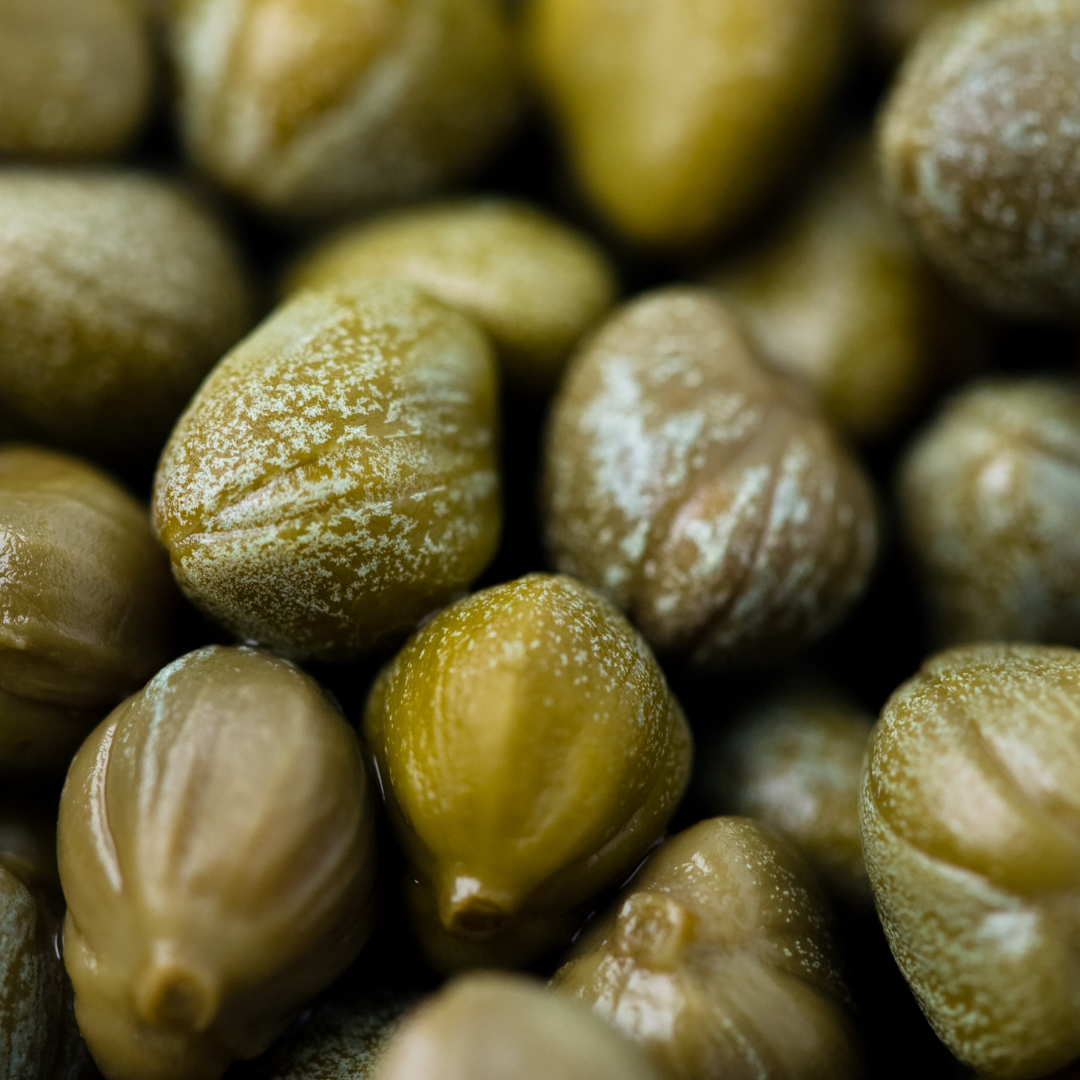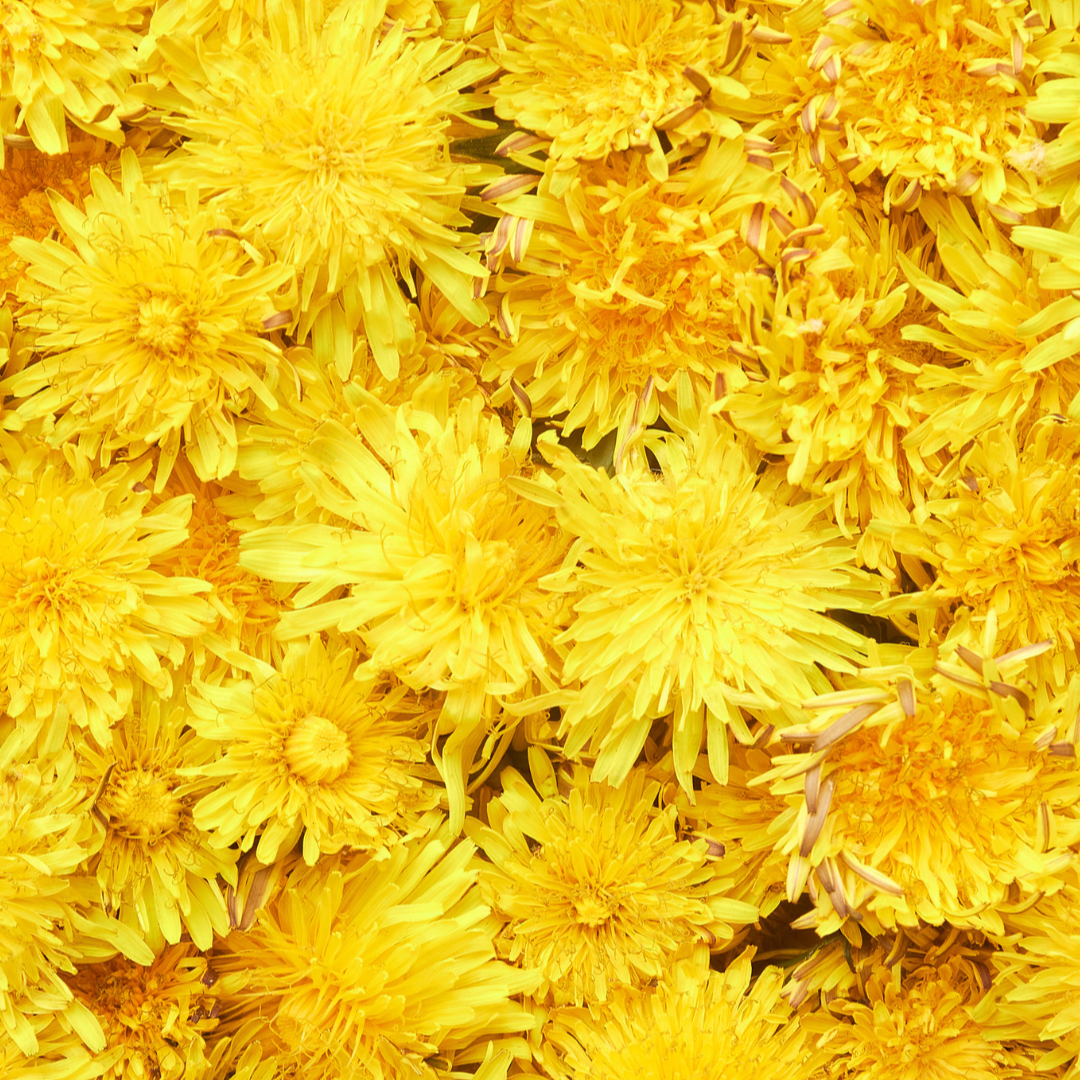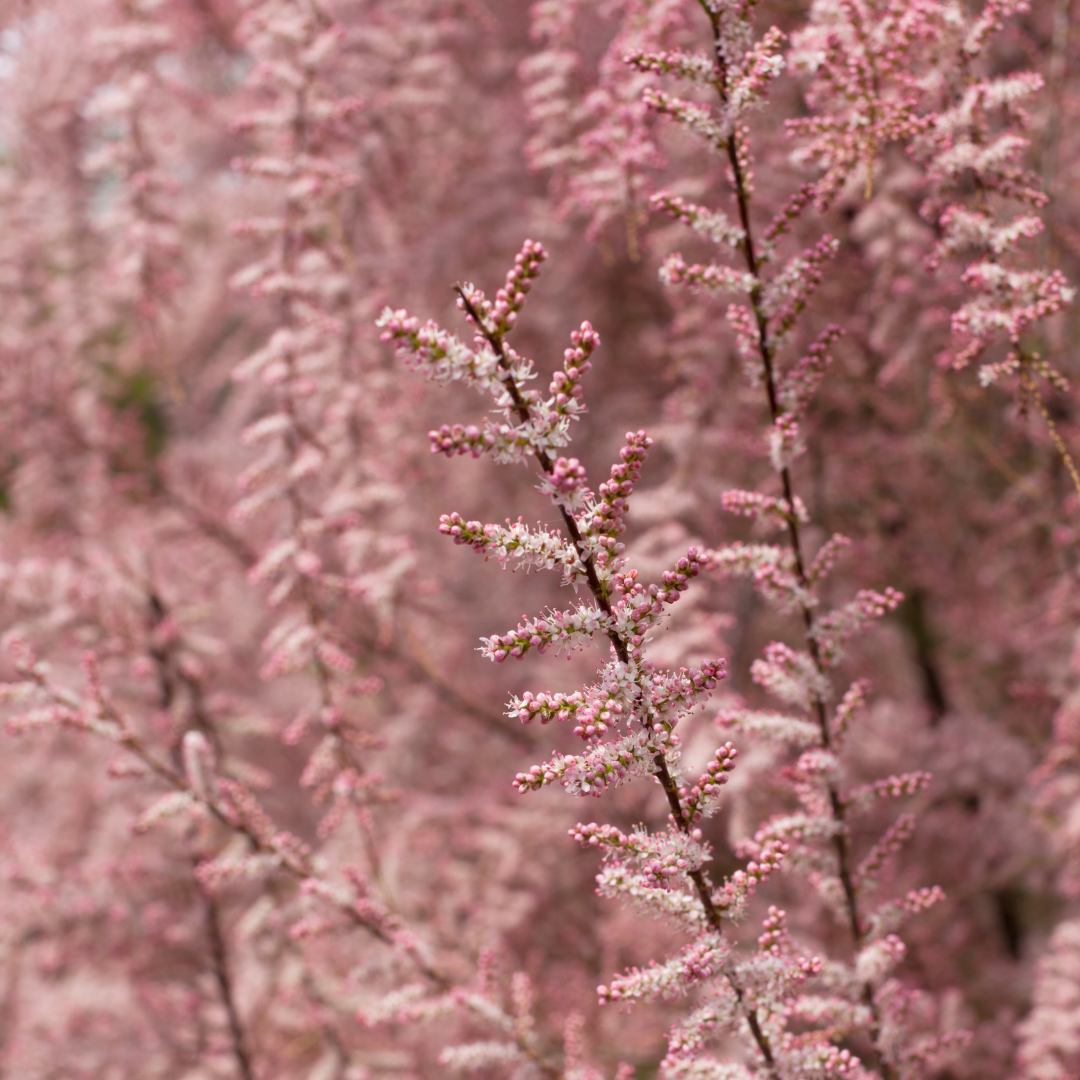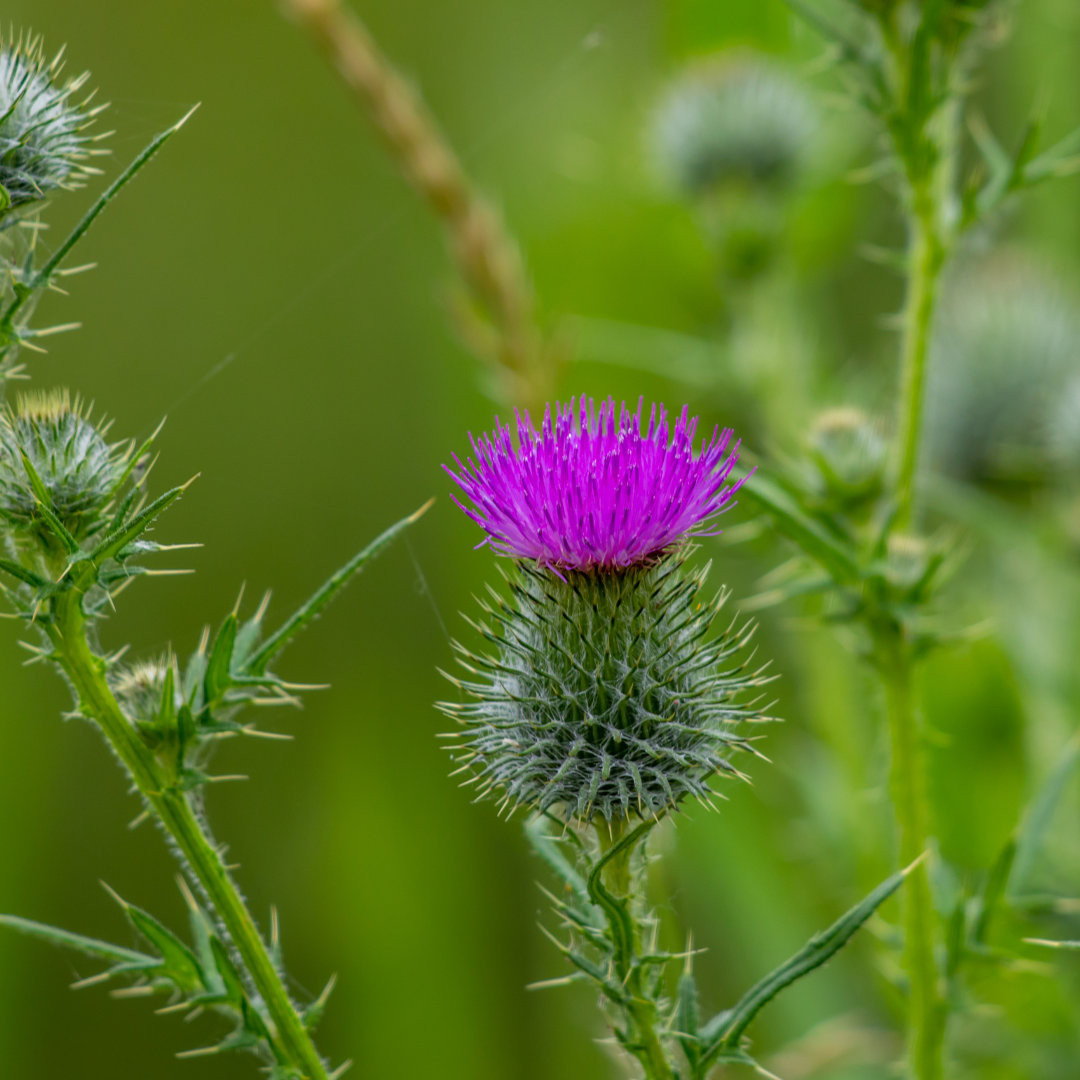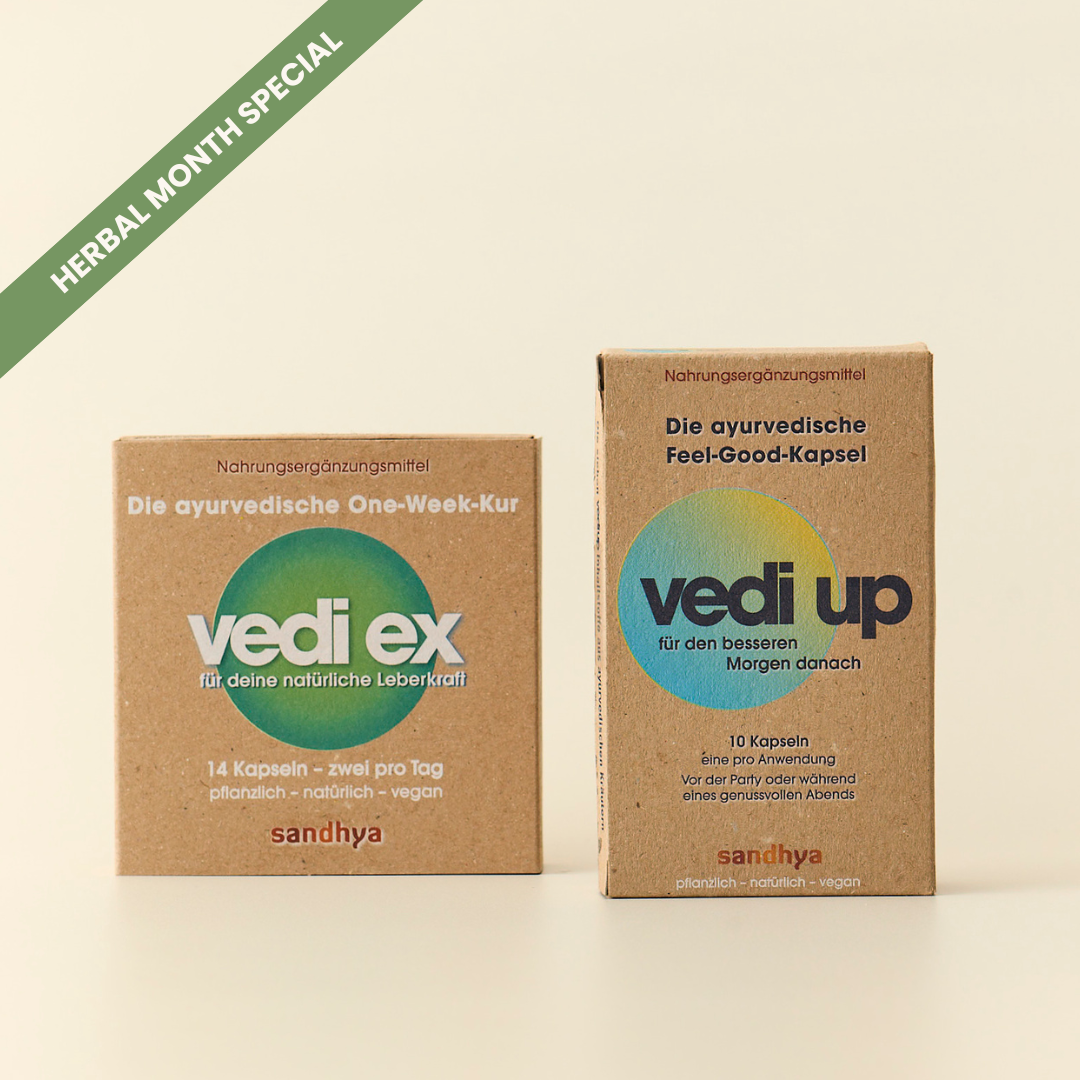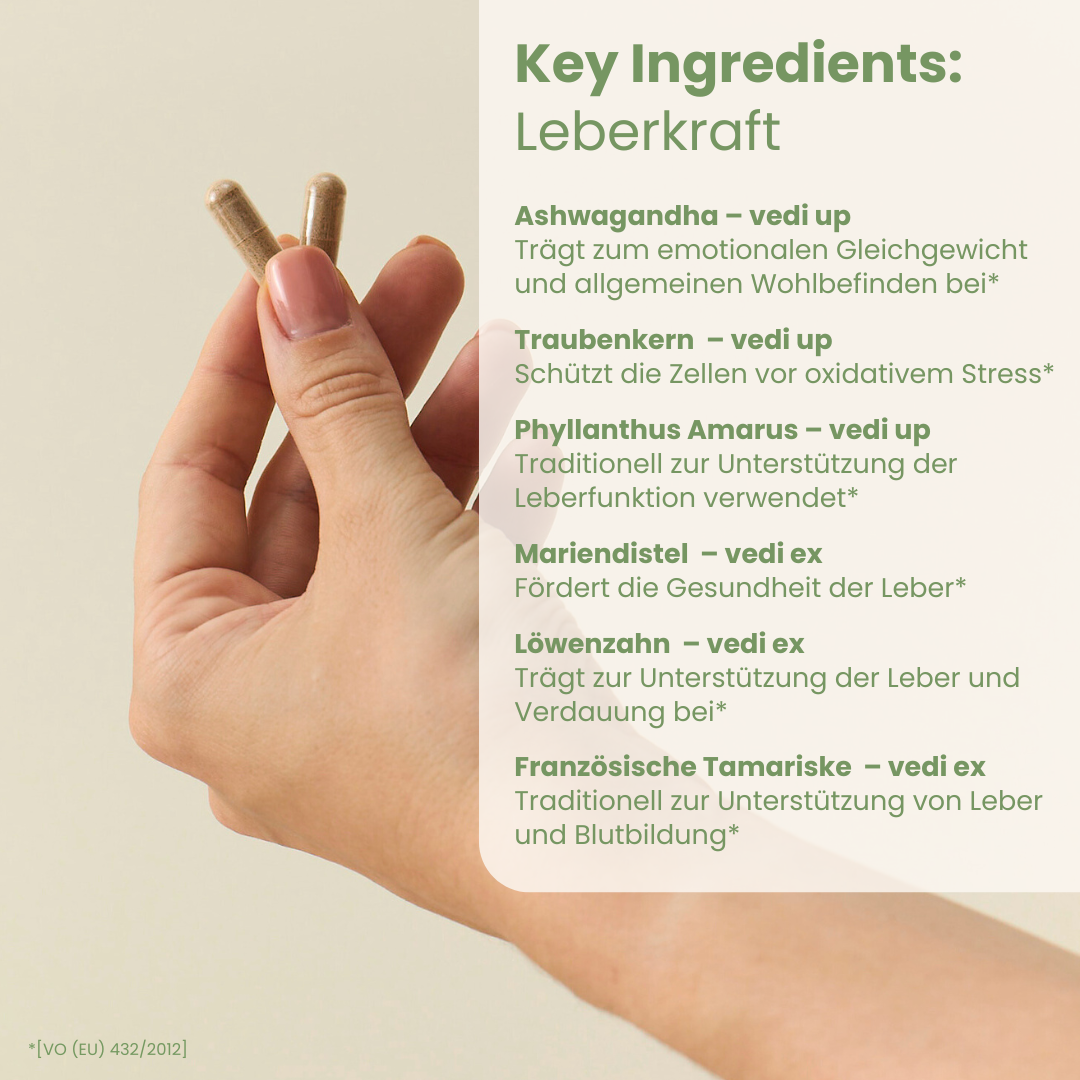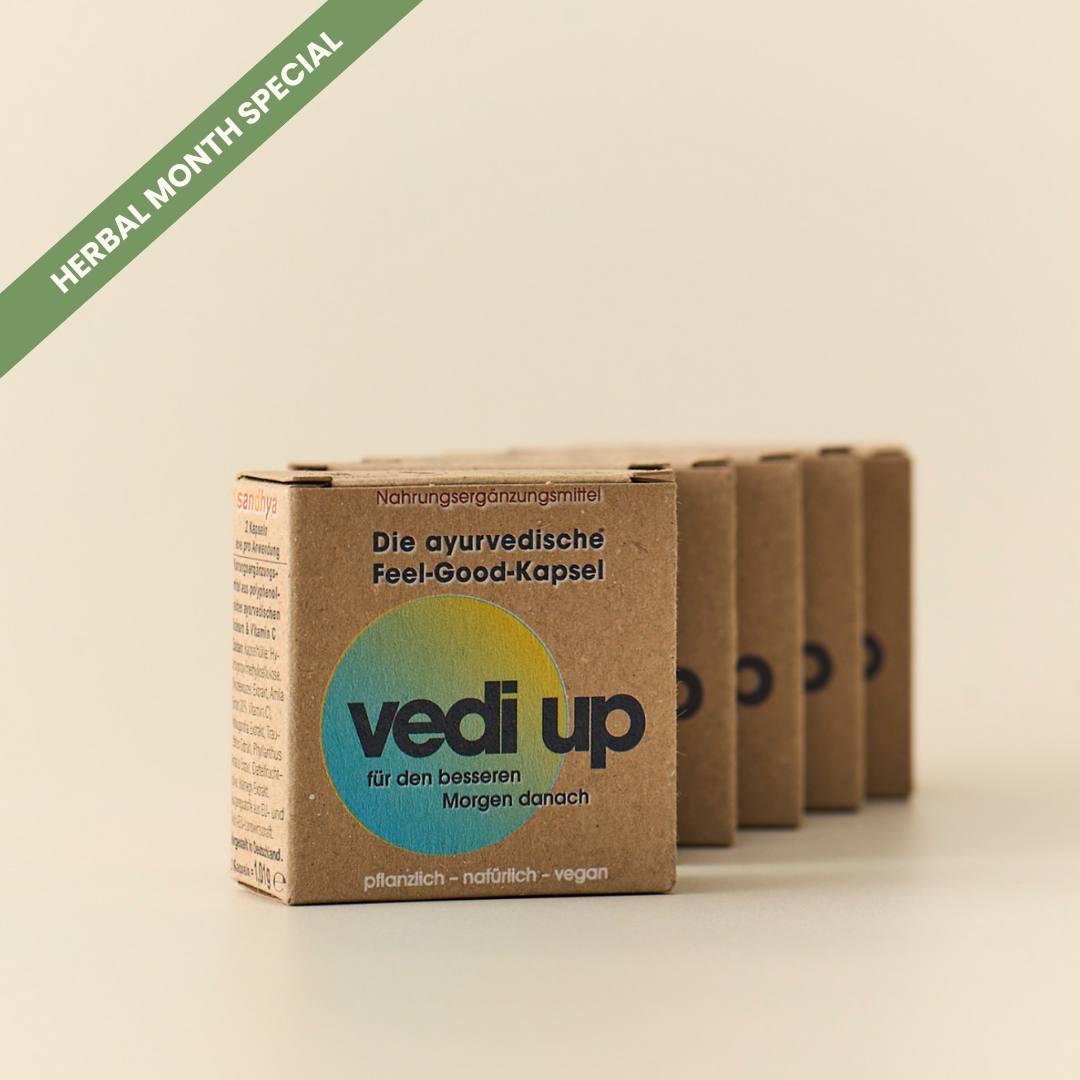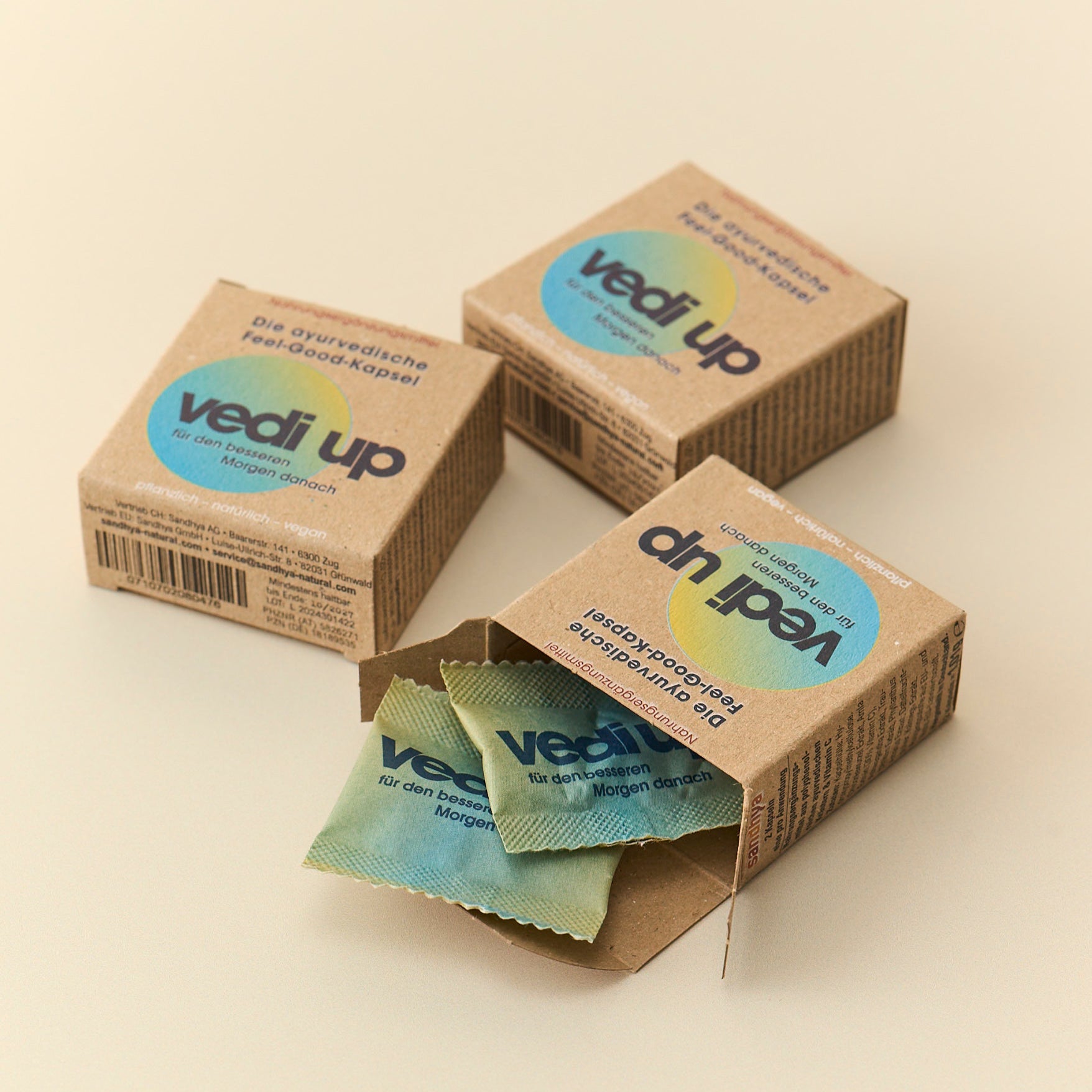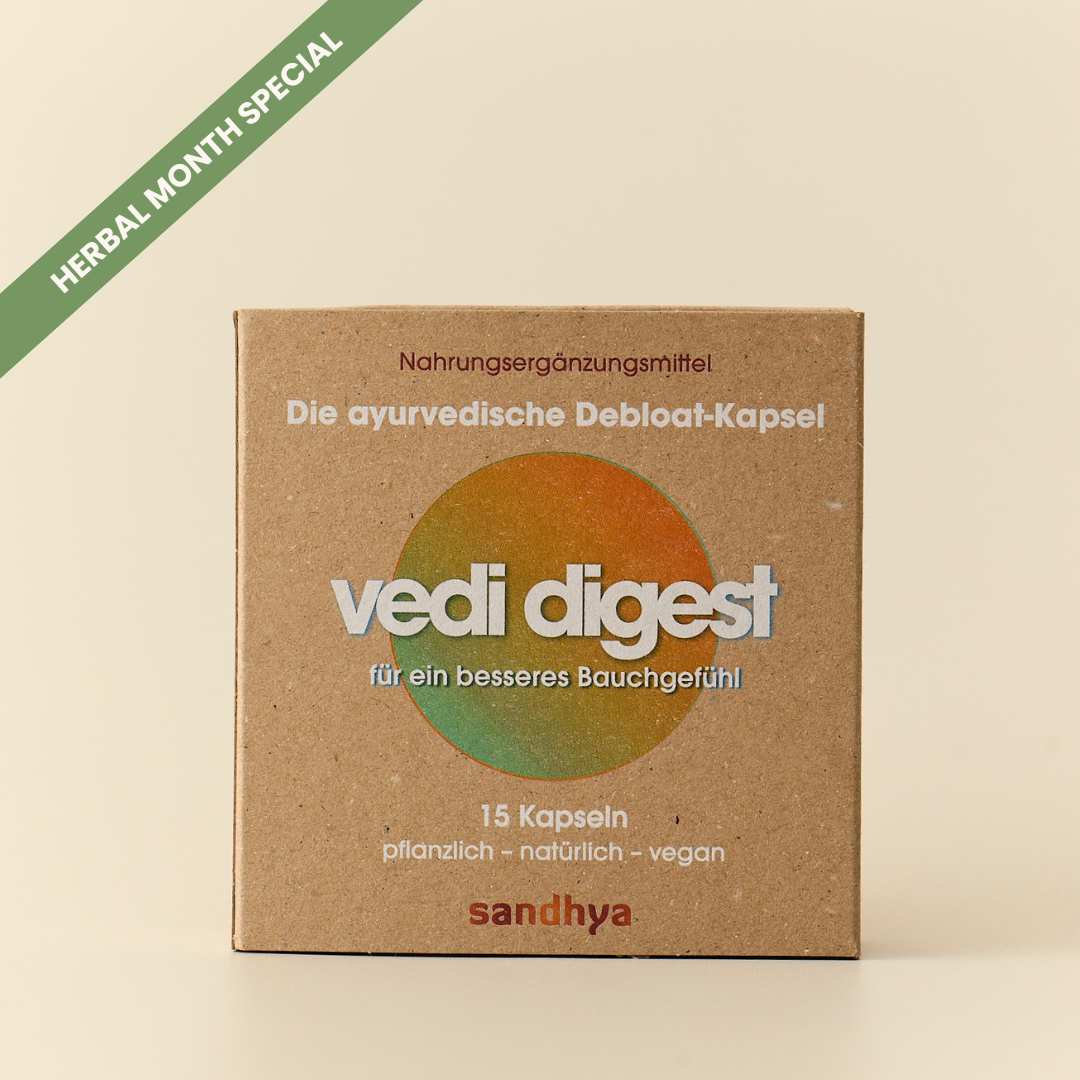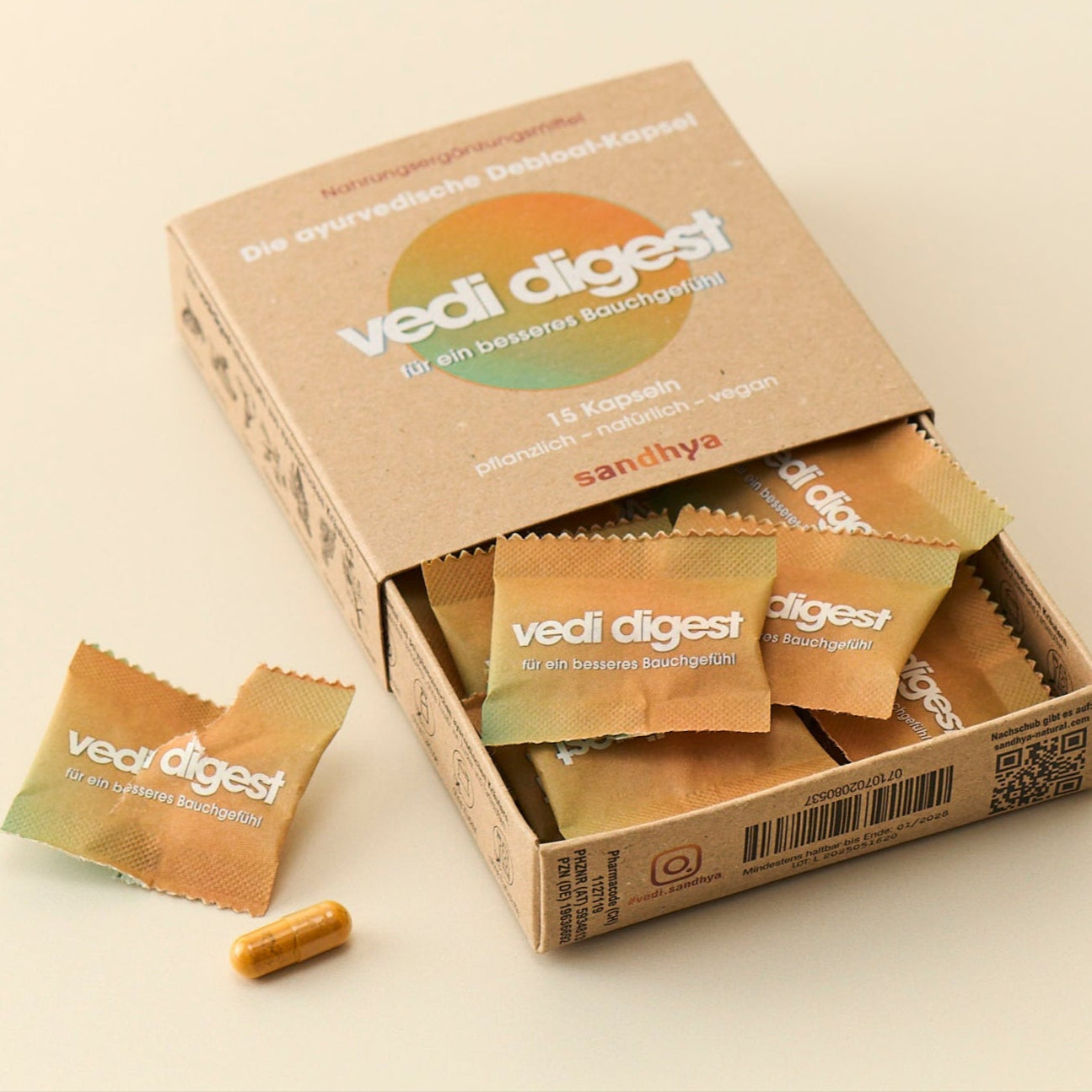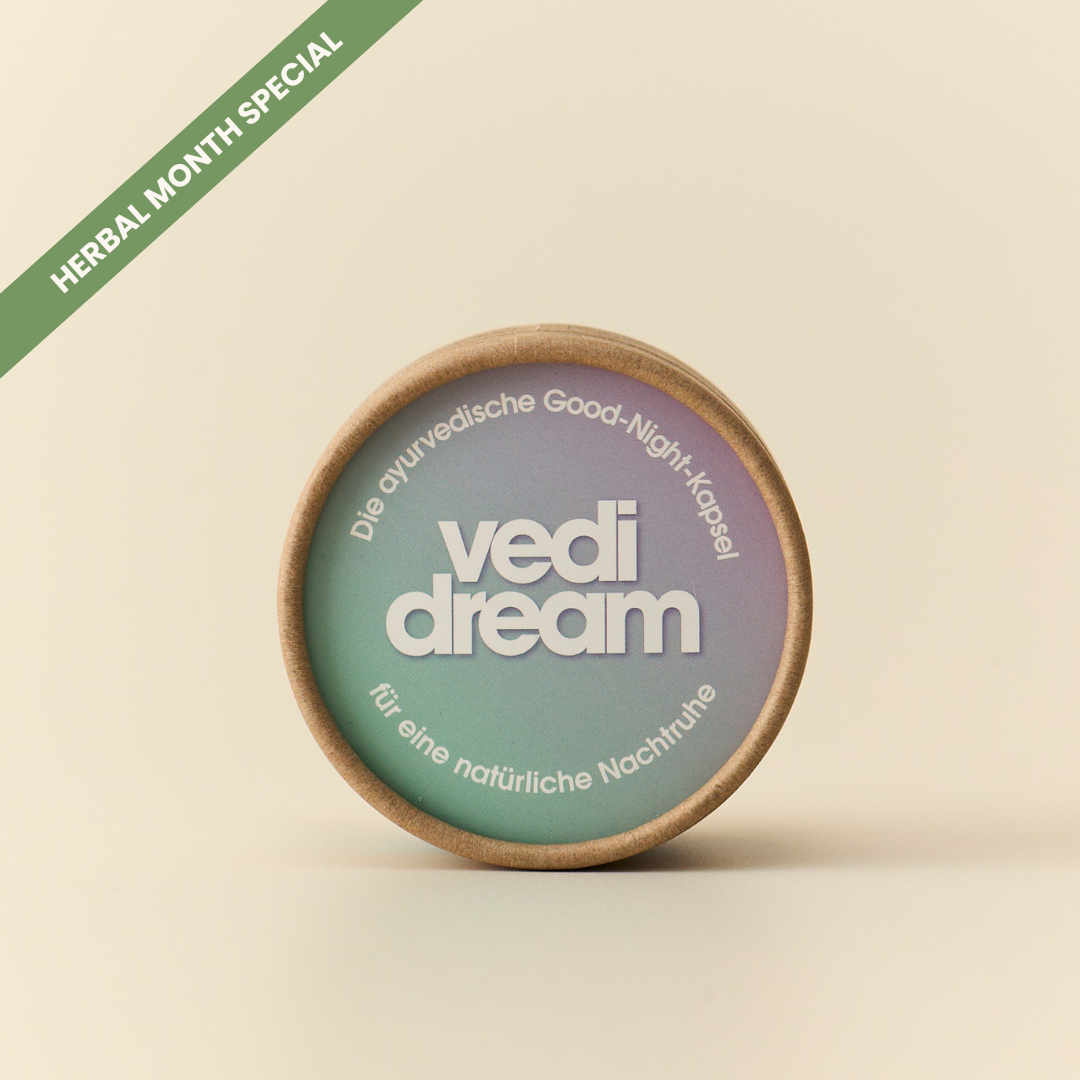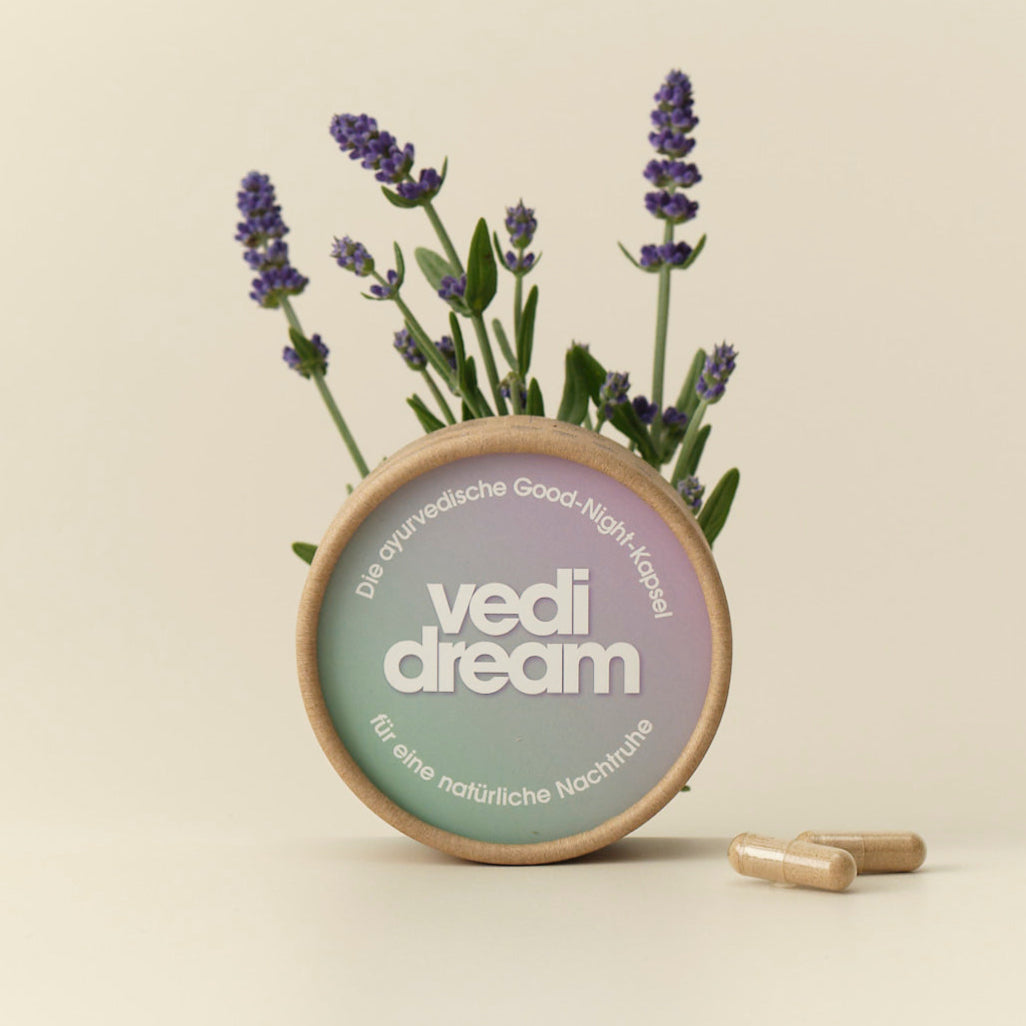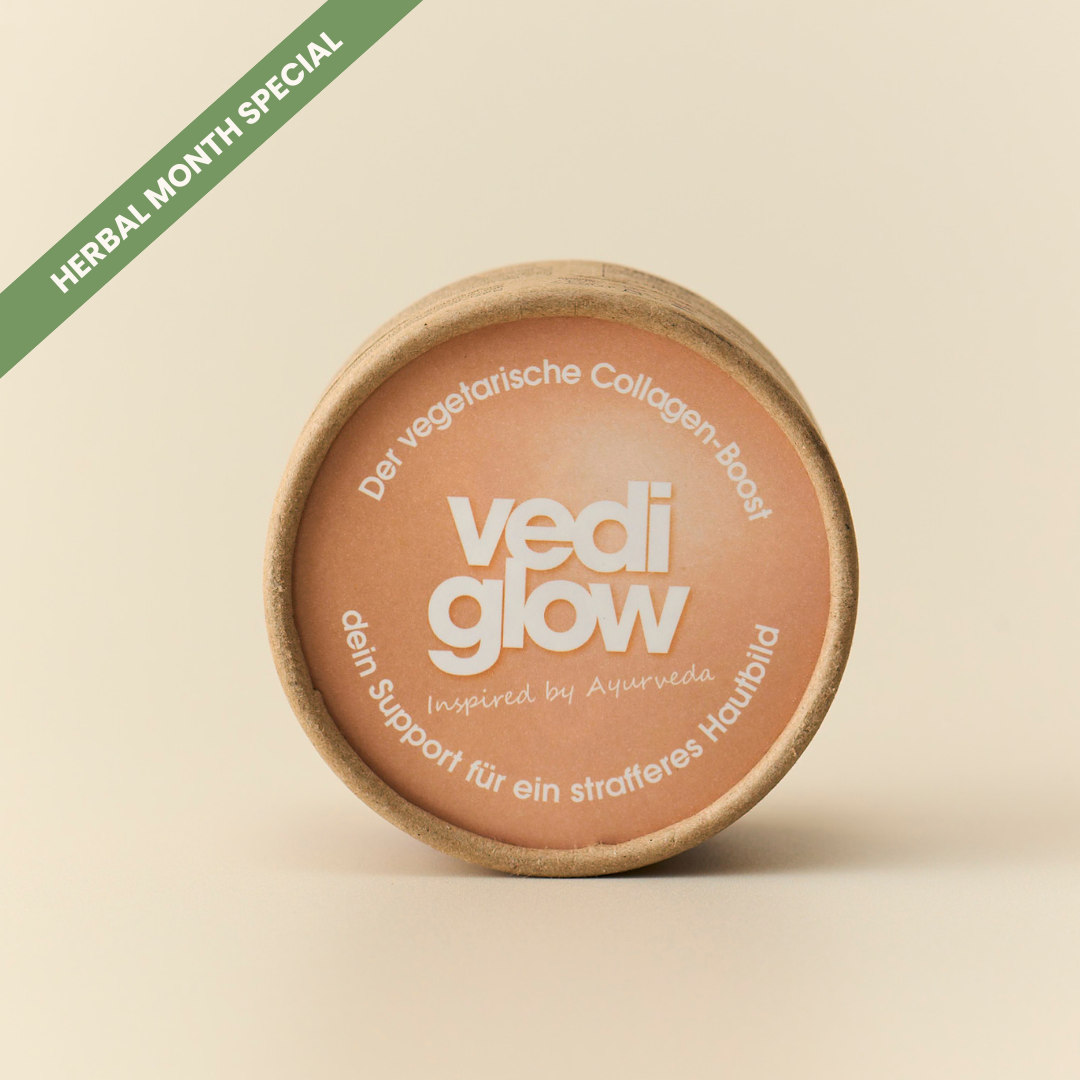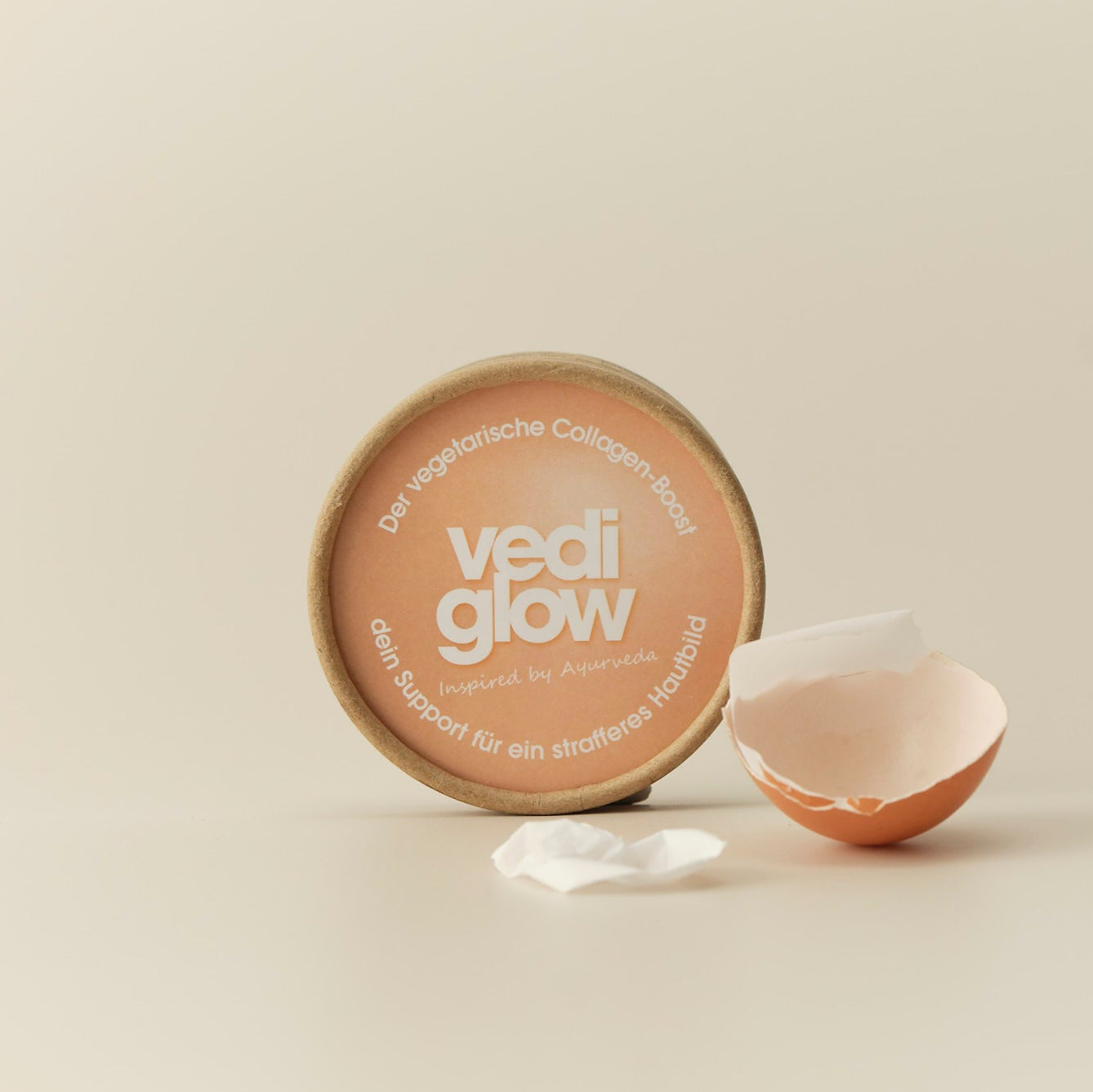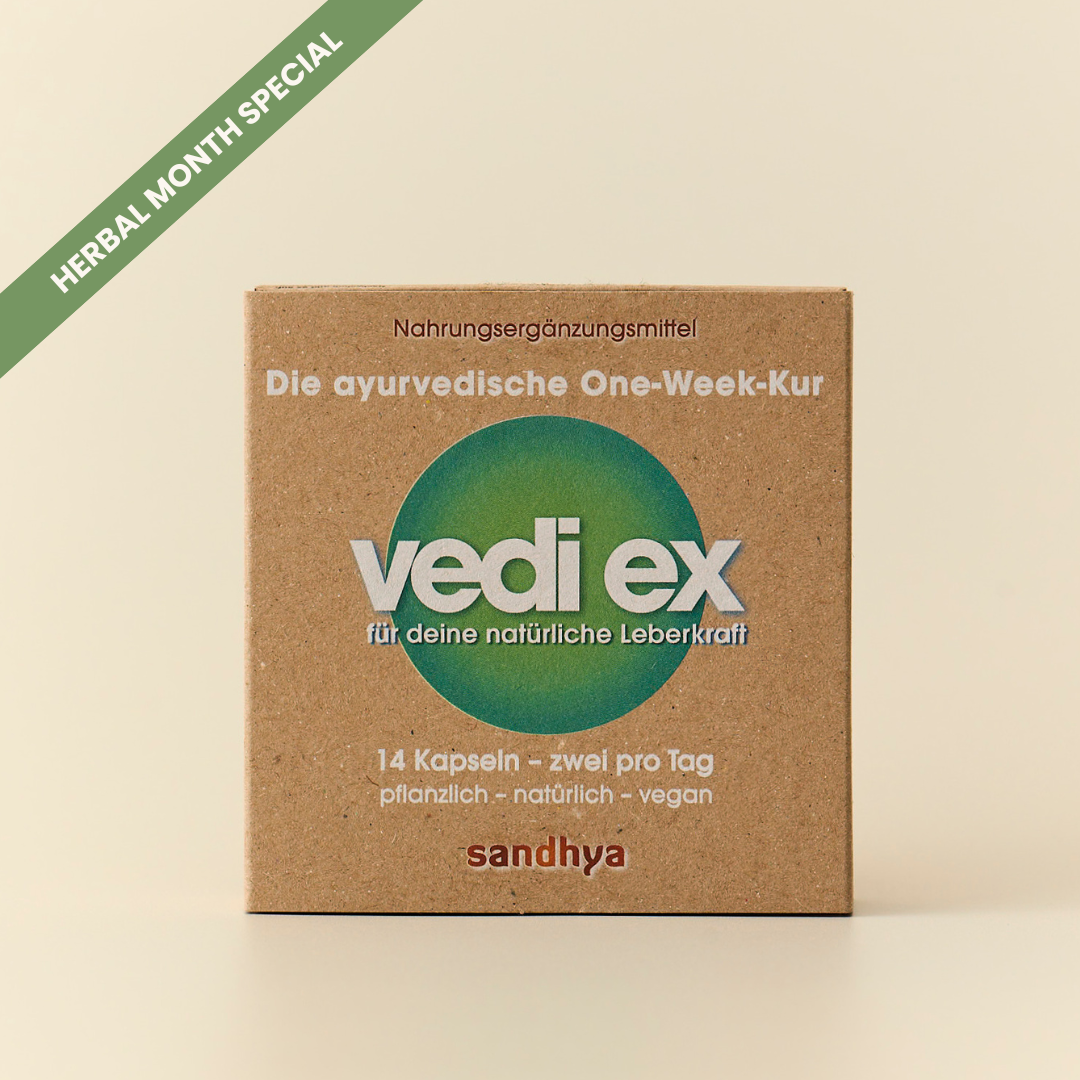
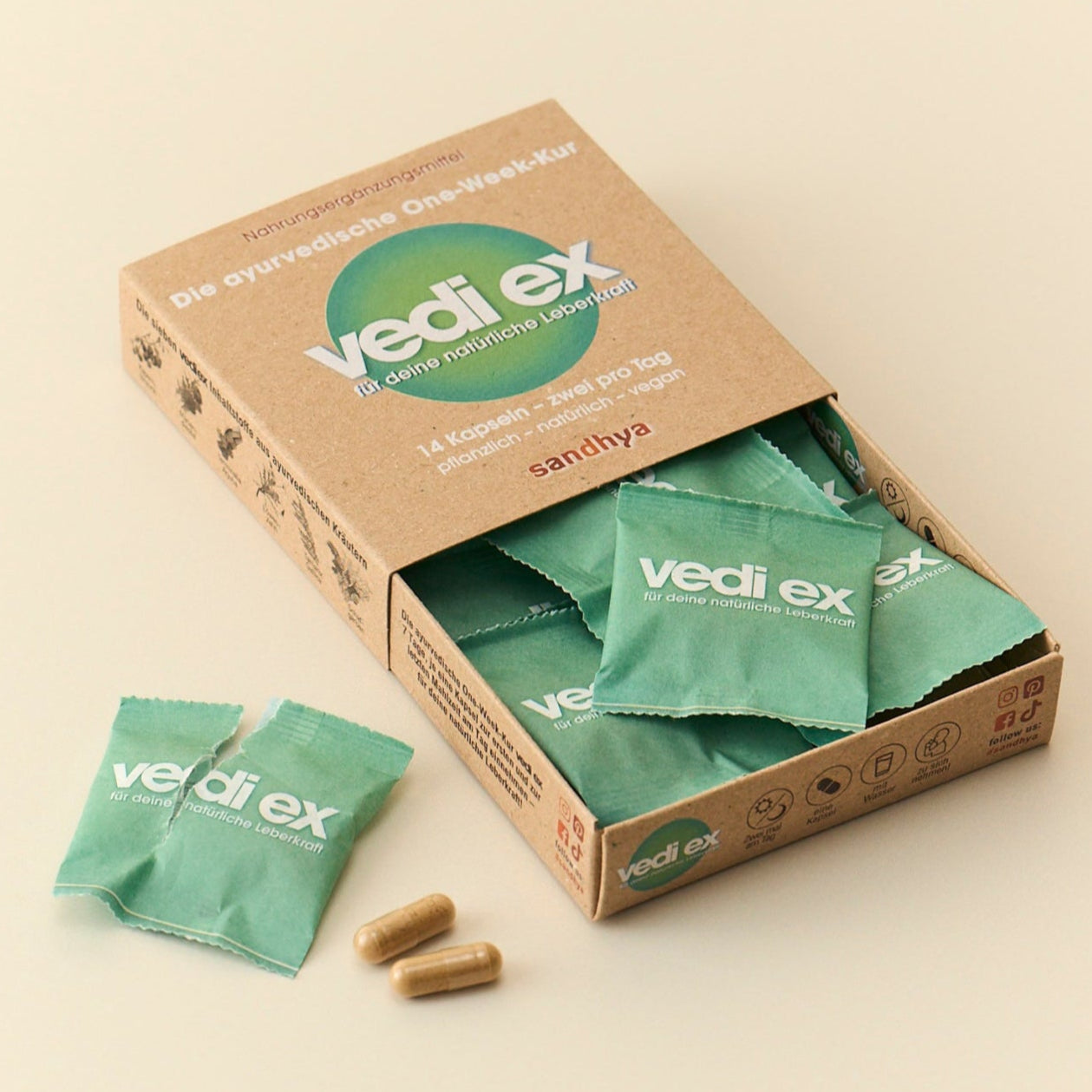
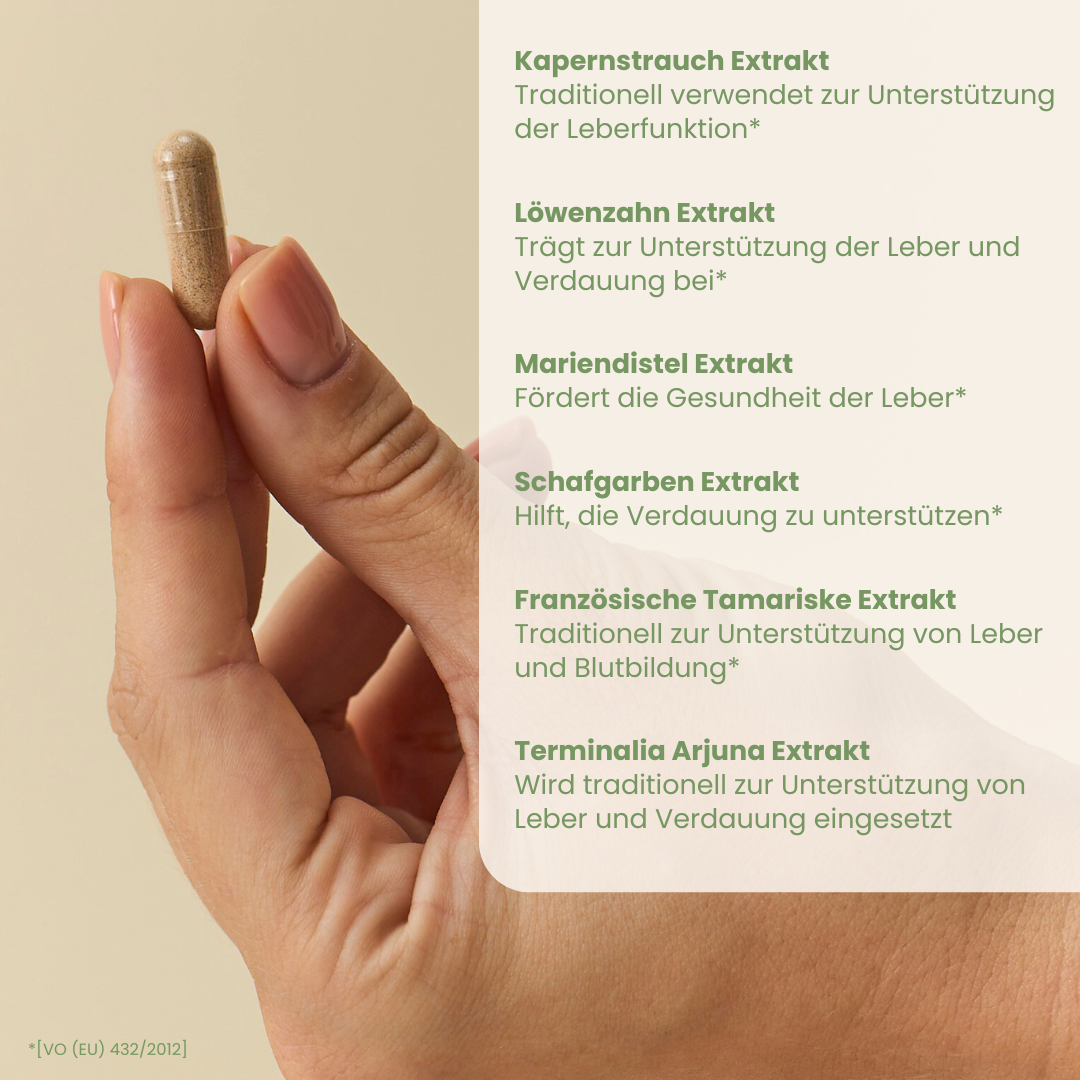
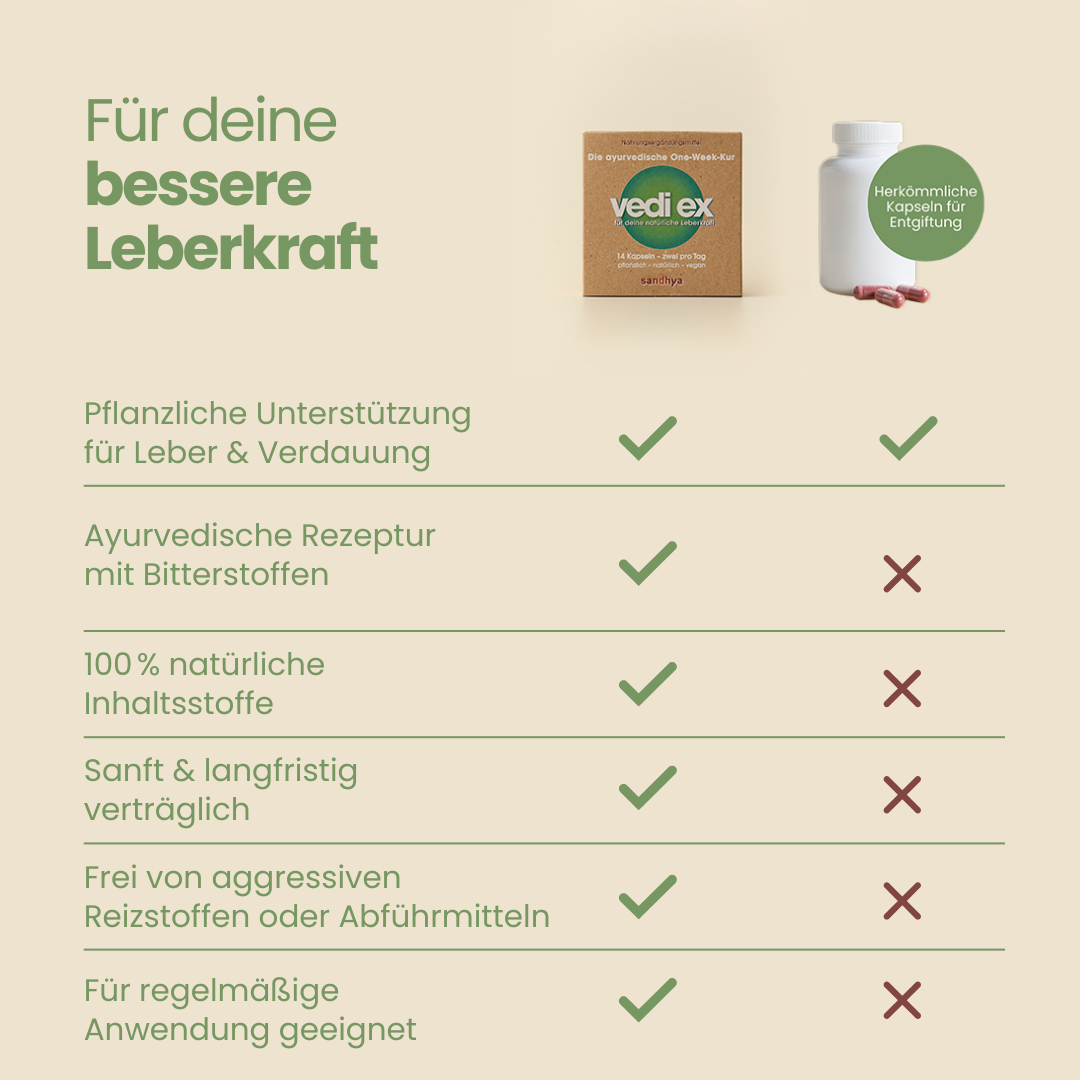
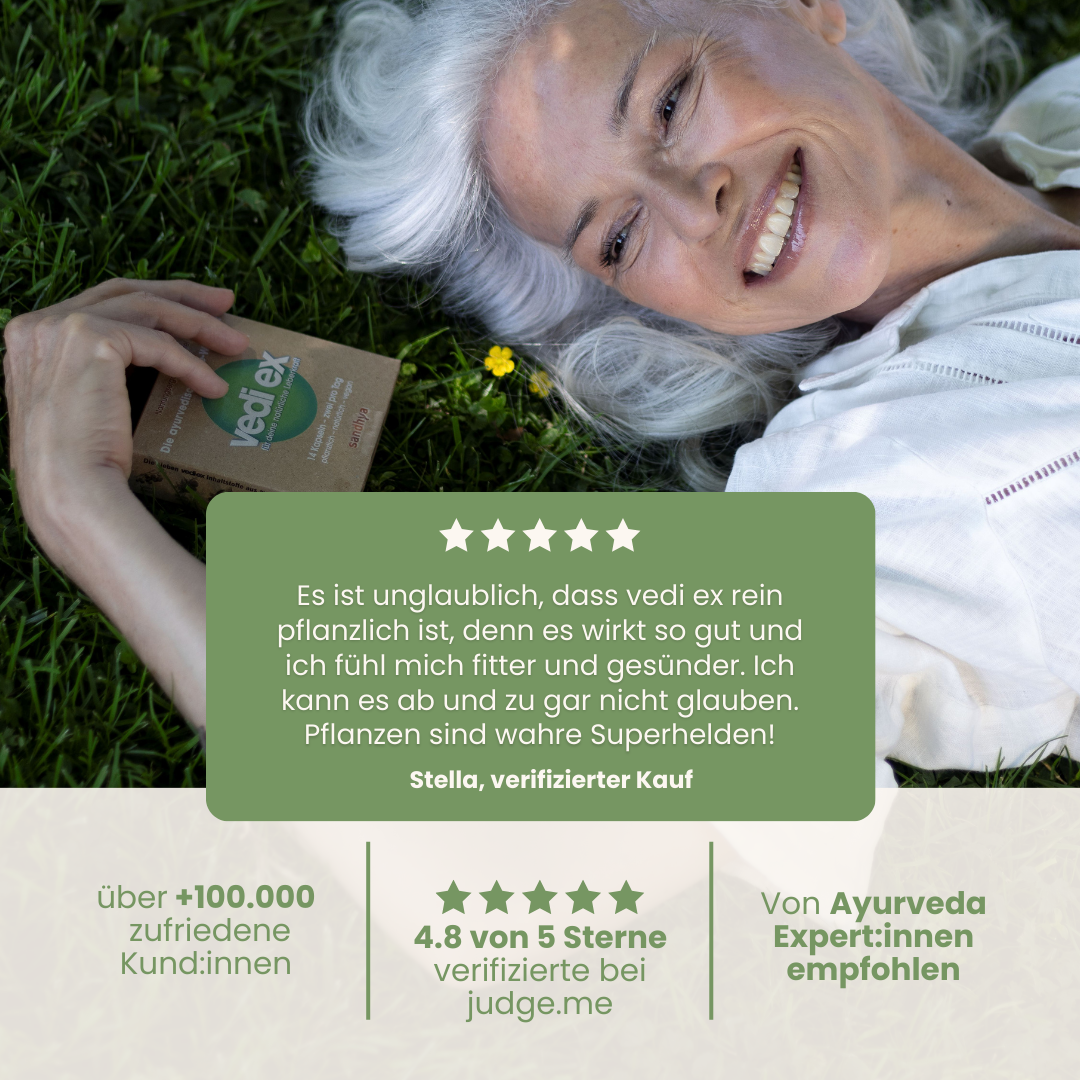

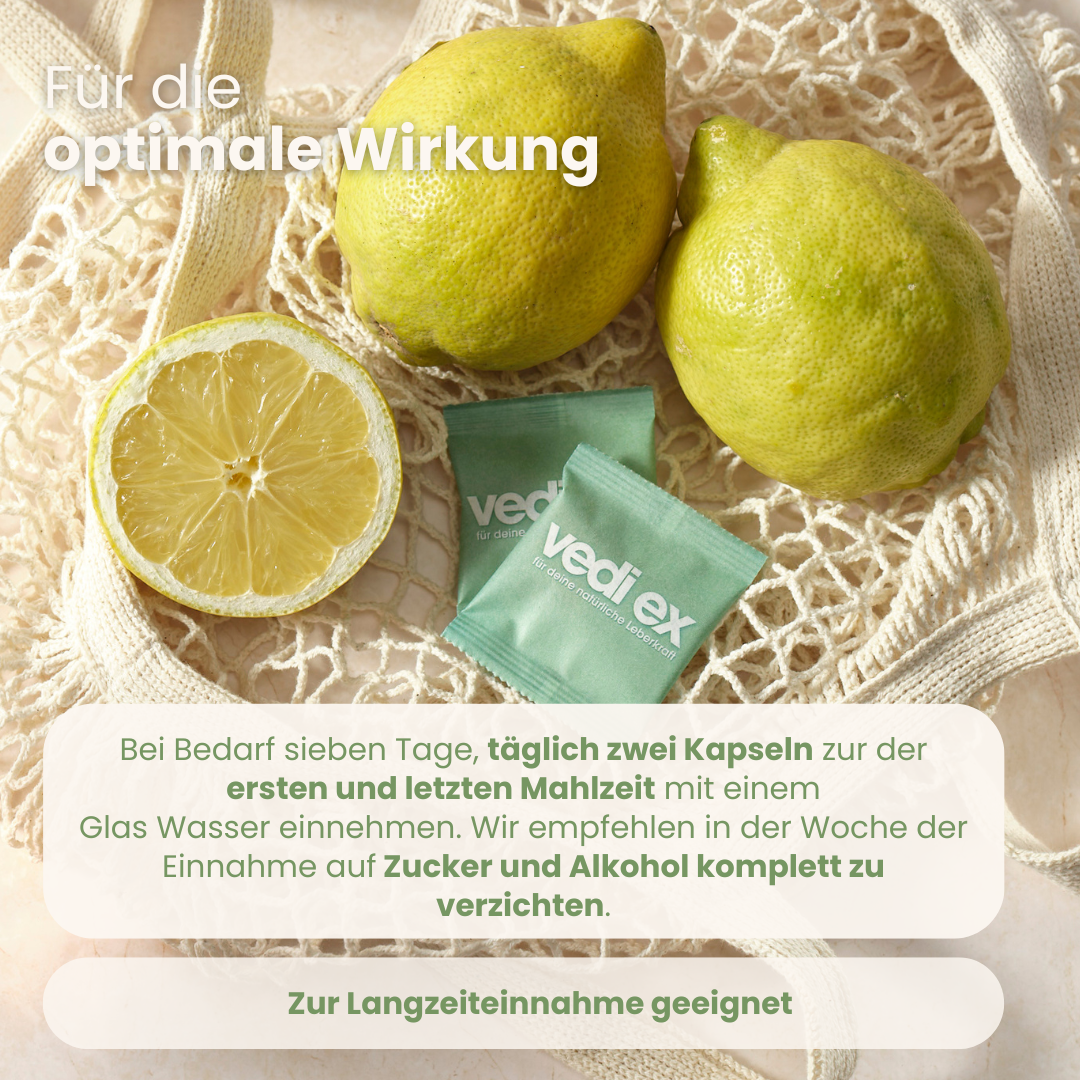
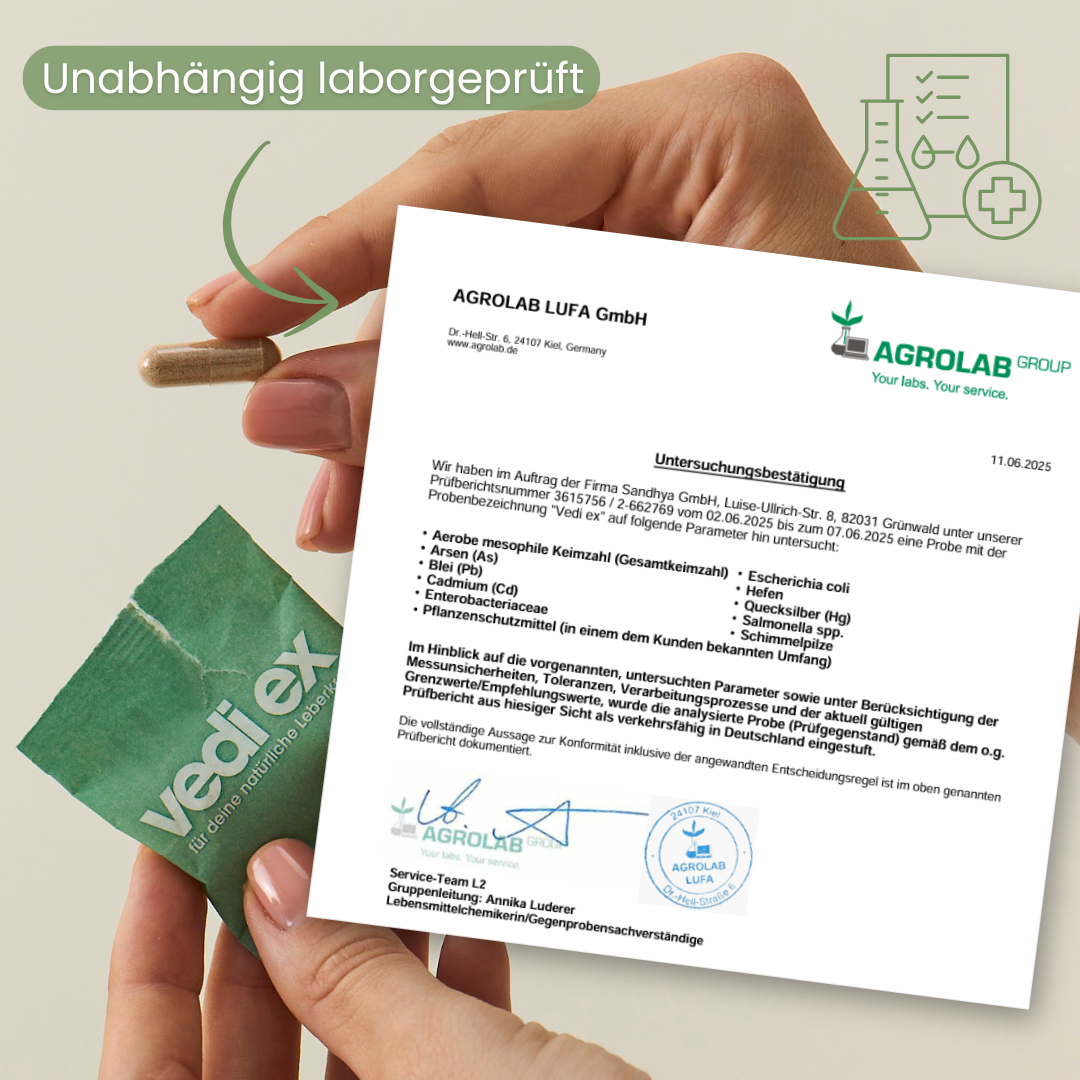

Leberkraft-Kur
vedi ex Box (14 Kapseln)
Die ayurvedische Rezeptur wurde speziell entwickelt, um Vitalität und Balance auf natürliche Weise wiederherzustellen – für deinen monatlichen Wohlfühl-Reset und neue Leberkraft.
- 100% natürliche Inhaltsstoffe
- Kostenloser Versand ab 60€ MBW
Kraftvolle Bitterstoffe für Leberkraft*
Laborgeprüfte Qualität
Pflanzenextrakte mit leberfördernden Eigenschaften*
 Von Experten*innen in der Schweiz entwickelt
Von Experten*innen in der Schweiz entwickelt
Die vedi ex One-Week-Kur aus 6 ayurvedischen Pflanzenextrakten:
Zutaten: Kapernstrauch Extrakt (Campari spinosa), Mariendistel Extrakt, Terminalia
arjuna Extrakt, Löwenzahn Extrakt 4:1, Französische Tamariske Extrakt (Tamarix
gallica), Schafgarben Extrakt, Reisextrakt. Kapselhülle: Hydroxypropylmethylcellulose (vegan).
PZN DE:
Häufig gestellte Fragen zu vedi ex:
Wann und wie wird vedi ex angewendet?
vedi ex ist als eine 1-wöchige Kur konzipiert und kann bei Bedarf einmal im Monat durchgeführt werden. Jeden Morgen und Abend jeweils eine Kapsel vor dem Essen einnehmen. Wir empfehlen in dieser Woche auf Zucker und Alkohol weitestgehend zu Verzichten.
Was macht vedi ex so außergewöhnlich?
Die einzigartige ayurvedische Rezeptur. Unsere vedi ex Kapseln enthalten von Experten ausgewählte kostbare Pflanzenextrakte, die reich an natürlichen & wertvollen Bitterstoffen, Mineralstoffen und Vitaminen sind. In der ayurvedischen Lehre werden diese Inhaltsstoffe unter anderem zur Förderung des Leberschutzes eingesetzt.
Wie schnell tritt die Wirkung ein?
Die Wirkung hängt immer von deinem Körper individuell ab. Unsere Kapseln bestehen aus einer Rezeptur reiner Naturstoffe in hochwertigster Qualität, hochdosiert und mit Wirkstoffkonzentration. Wir empfehlen eine kontinuierliche Einnahme über die gesamte Woche. Bitterstoffe entfalten ihre Wirkung im Körper relativ schnell mit der Verdauung.
Weitere Fragen?
Du kannst uns jederzeit schreiben über service@sandhya-natural.com.
Verzehrempfehlung: Bei Bedarf sieben Tage, täglich zwei Kapseln (max. Dosis) zur der ersten und letzten Mahlzeit mit einem Glas Wasser einnehmen. Wir empfehlen in der Woche der Einnahme auf Zucker und Alkohol komplett zu verzichten.
Lagerhinweis: Geschlossen, kühl
(bei +4° bis +25° C) und trocken lagern.
Wichtige Hinweise: Nur für den Verzehr durch Erwachsene geeignet. Nicht für schwangere und stillende Frauen geeignet. Außerhalb der Reichweite von kleinen Kindern lagern. Die angegebene empfohlene tägliche Verzehrmenge darf nicht überschritten werden. Nahrungsergänzungsmittel sollten nicht als Ersatz für eine ausgewogene und abwechslungsreiche Ernährung verwendet werden.
Die Ayurveda ist reich an wertvollem, jahrtausendealtem Wissen, über welches man sehr viel berichten kann – auch zu den kraftvollen Pflanzenextrakten in vedi ex kann man etliche wissenschaftliche Studien aus der Phytotherapie finden, die erstaunliche positive Wirkungen der hochdosierten Inhaltsstoffe bestätigen.
Aufgrund gesetzlicher Regelungen ist es uns leider untersagt, zu diesen wertvollen Inhaltsstoffen unserer Produkte spezifische Wirkungsaussagen zu treffen. Deshalb sind bei einigen Produkten nur sehr wenige Informationen zur Wirkung zu finden. Wir haben daher umso mehr darauf geachtet, Studien zu den Inhaltsstoffen unserer natürlichen Produkte zu finden, um die Wirksamkeit zu bestätigen und Transparenz zu schaffen. Darüber hinaus kannst du selbst Recherche betreiben und dir dein eigenes Bild von den kostbaren Inhaltsstoffen unserer Produkte machen.Wir bitten um Verständnis dafür.
Stoffwechsel & Antioxidative Unterstützung -
Kapernstrauchextrakt (Capparis spinosa)
Perna, Rafique et al. (2023). "Effect of caper fruit (Capparis spinosa L.) consumption on liver enzymes, lipid profile, fasting plasma glucose, and weight loss. A systematic review and a preliminary meta-analysis of randomized controlled trials." Biomedicine & Pharmacotherapy, 168, 115638.
Link zur Studie
Vahid, Rakhshandeh, et al. (2017). "Antidiabetic properties of Capparis spinosa L. and its components." Biomedicine & Pharmacotherapy, 92, 293-302.
Link zur Studie
Tlili, Feriani, et al. (2017). "Capparis spinosa leaves extract: Source of bioantioxidants with nephroprotective and hepatoprotective effects." Biomedicine & Pharmacotherapy, 87, 171-179.
Link zur Studie
Leberregeneration & Schutz -Mariendistelextrakt (Silymarin):
Federico, Dallio et al. "Silymarin/Silybin and Chronic Liver Disease: A Marriage of Many Years." Molecules. 2017;22(2):191. Link zur Studie
Gillessen, Schmidt. "Silymarin as Supportive Treatment in Liver Diseases: A Narrative Review." Adv Ther. 2020;37(3):1279–1301. Link zur Studie
Aghemo, Alekseeva et al. "Role of silymarin as antioxidant in clinical management of chronic liver diseases: a narrative review." Annals of Medicine. 2022;54(1):1548-1560.
Link zur Studie
Entgiftung &
Leberschutz- Löwenzahnextrakt (Taraxacum officinale)
Pfingstgraf, Taulescu et al. "Protective Effects of Taraxacum officinale L. (Dandelion) Root Extract in Experimental Acute on Chronic Liver Failure." Antioxidants.
2021;10(4):504.
Link zur Studie
Park, Park et al. "Taraxacum officinale Weber extracts inhibit LPS-induced oxidative stress and nitric oxide production via the NF-κB modulation in RAW 264.7 cells." Journal of Ethnopharmacology. 2011;133(2):834-842.
Link zur Studie
Davaatseren, Jeon Hur et al. "Taraxacum official (dandelion) leaf extract alleviates high-fat diet-induced nonalcoholic fatty liver." Food and Chemical Toxicology. 2013;58:30-36.
Link zur Studie
Herz-Kreislauf- und Lebergesundheit: Terminalia arjuna
Kokkiripati, Kamsala et al. "Stem-bark of Terminalia arjuna attenuates human monocytic (THP-1) and aortic endothelial cell activation." Journal of Ethnopharmacology. 2013;146(2):456-464.
Link zur Studie
Toppo, Darvin et al. "Curative effect of arjunolic acid from Terminalia arjuna in non-alcoholic fatty liver disease models." Biomedicine & Pharmacotherapy. 2018;107:979-988.
Link zur Studie
Traditionelle Heilpflanze- Schafgarbe (Achillea millefolium):
Benedek, Kopp. "Achillea millefolium L. s.l. revisited: recent findings confirm the traditional use." Wien Med Wochenschr. 2007;157(13-14):312–314.
Link zur Studie
Hadavi-Siahboomi, Yegdaneh et al. "Ulcer-Healing Effect of Hydroalcoholic Extract and Essential Oil of Achillea millefolium L. on Murine Model of Colitis." Int J Prev Med. 2022;13:155.
Link zur Studie
Antioxidative Aktivitäten - Tamarix Gallica
Nisar, Muhammad Ali Shah et al. (2023). "In vitro comparative evaluation of Tamarix gallica extracts for antioxidant and
antidiabetic activity." Experimental
Biology and Medicine, 248(3), 253-262.
Link zur Studie
Kalai, Oueslati et al. "Chemical profiling of maceration and decoction of Tamarix gallica L. organs and in vitro biological properties." International Journal of Environmental Health Research. Link zur Studie
Ksouri, Falleh et al. (2009). "Antioxidant and antimicrobial activities of the edible medicinal halophyte Tamarix gallica L. and
related polyphenolic constituents." Food and Chemical Toxicology, 47(8), 2083-2091.
Link zur Studie

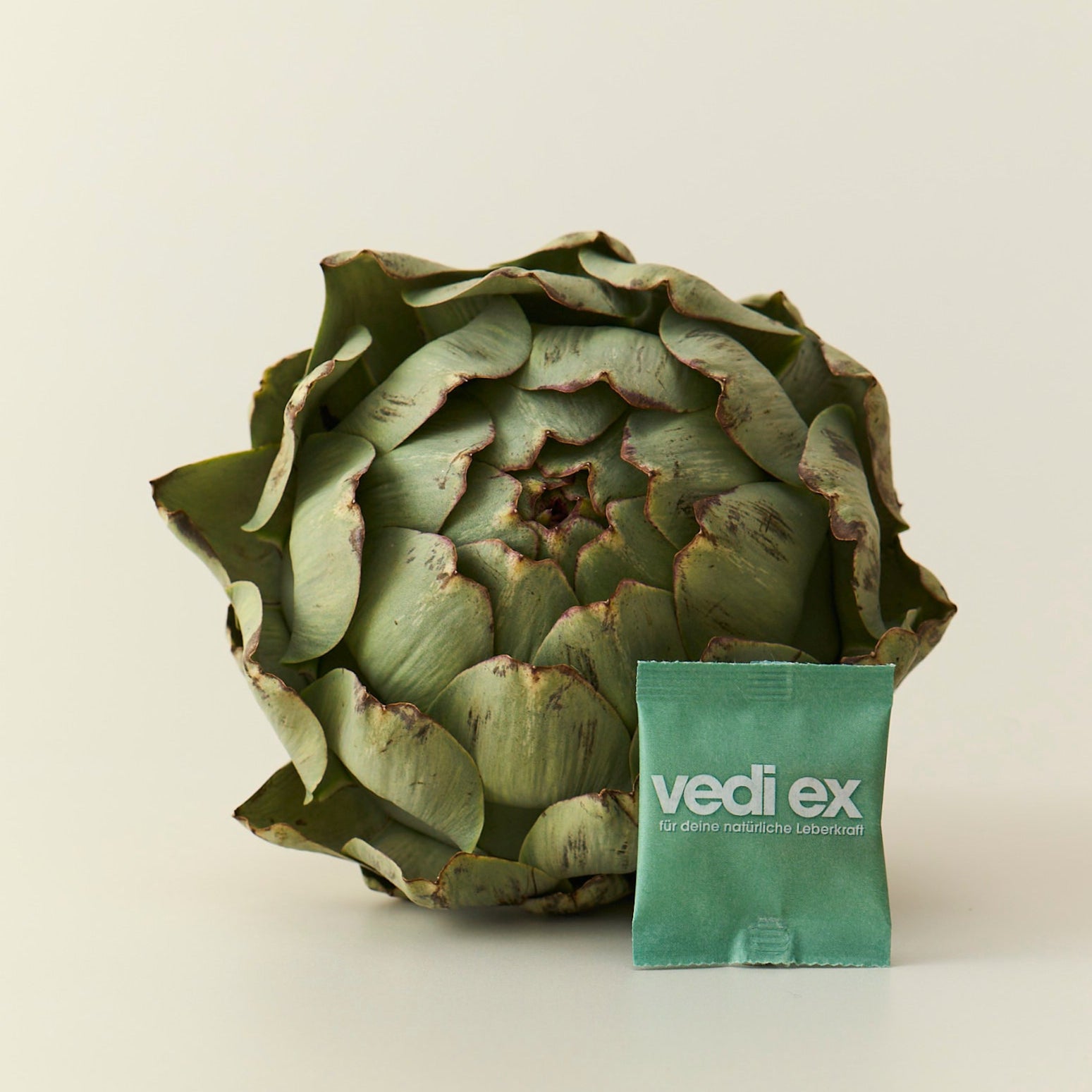
Wie es funktioniert
In letzter Zeit öfter mal zu Süßem, Alkohol oder schwerem Essen gegriffen? Dann ist jetzt ein guter Moment, um Deinem Körper eine kleine Pause zu gönnen.
vedi ex ist unsere ayurvedisch inspirierte One-Week-Kur mit sorgfältig ausgewählten Pflanzenextrakten. Die Rezeptur basiert auf traditionellen Anwendungen und ist ideal für alle, die sich nach mehr Leichtigkeit und bewussten Routinen im Alltag sehnen.
Gönn Dir Zeit für Dich – achtsam, natürlich und ganz ohne Verzicht.
100% PFLANZENKRAFT
Key-Inhaltsstoffe
Die sorgfältig abgestimmte Zusammensetzung aus sechs Pflanzenextrakten macht vedi ex zur idealen Reset-Kur.
Anderes Produkt gefällig?



